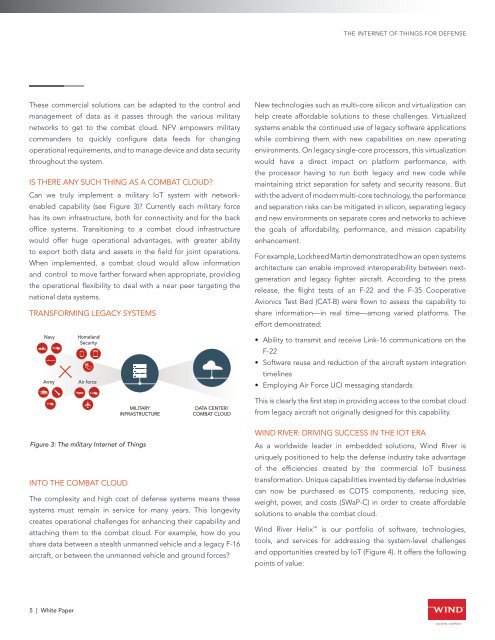THE INTERNET OF THINGS FOR DEFENSE
wind-river_%20IoT-in-Defense_white-paper
wind-river_%20IoT-in-Defense_white-paper
Create successful ePaper yourself
Turn your PDF publications into a flip-book with our unique Google optimized e-Paper software.
<strong>THE</strong> <strong>INTERNET</strong> <strong>OF</strong> <strong>THINGS</strong> <strong>FOR</strong> <strong>DEFENSE</strong><br />
These commercial solutions can be adapted to the control and<br />
management of data as it passes through the various military<br />
networks to get to the combat cloud. NFV empowers military<br />
commanders to quickly configure data feeds for changing<br />
operational requirements, and to manage device and data security<br />
throughout the system.<br />
IS <strong>THE</strong>RE ANY SUCH THING AS A COMBAT CLOUD?<br />
Can we truly implement a military IoT system with networkenabled<br />
capability (see Figure 3)? Currently each military force<br />
has its own infrastructure, both for connectivity and for the back<br />
office systems. Transitioning to a combat cloud infrastructure<br />
would offer huge operational advantages, with greater ability<br />
to export both data and assets in the field for joint operations.<br />
When implemented, a combat cloud would allow information<br />
and control to move farther forward when appropriate, providing<br />
the operational flexibility to deal with a near peer targeting the<br />
national data systems.<br />
TRANS<strong>FOR</strong>MING LEGACY SYSTEMS<br />
New technologies such as multi-core silicon and virtualization can<br />
help create affordable solutions to these challenges. Virtualized<br />
systems enable the continued use of legacy software applications<br />
while combining them with new capabilities on new operating<br />
environments. On legacy single-core processors, this virtualization<br />
would have a direct impact on platform performance, with<br />
the processor having to run both legacy and new code while<br />
maintaining strict separation for safety and security reasons. But<br />
with the advent of modern multi-core technology, the performance<br />
and separation risks can be mitigated in silicon, separating legacy<br />
and new environments on separate cores and networks to achieve<br />
the goals of affordability, performance, and mission capability<br />
enhancement.<br />
For example, Lockheed Martin demonstrated how an open systems<br />
architecture can enable improved interoperability between nextgeneration<br />
and legacy fighter aircraft. According to the press<br />
release, the flight tests of an F-22 and the F-35 Cooperative<br />
Avionics Test Bed (CAT-B) were flown to assess the capability to<br />
share information—in real time—among varied platforms. The<br />
effort demonstrated:<br />
Navy<br />
Army<br />
Homeland<br />
Security<br />
Air force<br />
• Ability to transmit and receive Link-16 communications on the<br />
F-22<br />
• Software reuse and reduction of the aircraft system integration<br />
timelines<br />
• Employing Air Force UCI messaging standards<br />
MILITARY<br />
INFRASTRUCTURE<br />
DATA CENTER/<br />
COMBAT CLOUD<br />
This is clearly the first step in providing access to the combat cloud<br />
from legacy aircraft not originally designed for this capability.<br />
Figure 3: The military Internet of Things<br />
INTO <strong>THE</strong> COMBAT CLOUD<br />
The complexity and high cost of defense systems means these<br />
systems must remain in service for many years. This longevity<br />
creates operational challenges for enhancing their capability and<br />
attaching them to the combat cloud. For example, how do you<br />
share data between a stealth unmanned vehicle and a legacy F-16<br />
aircraft, or between the unmanned vehicle and ground forces?<br />
WIND RIVER: DRIVING SUCCESS IN <strong>THE</strong> IOT ERA<br />
As a worldwide leader in embedded solutions, Wind River is<br />
uniquely positioned to help the defense industry take advantage<br />
of the efficiencies created by the commercial IoT business<br />
transformation. Unique capabilities invented by defense industries<br />
can now be purchased as COTS components, reducing size,<br />
weight, power, and costs (SWaP-C) in order to create affordable<br />
solutions to enable the combat cloud.<br />
Wind River Helix is our portfolio of software, technologies,<br />
tools, and services for addressing the system-level challenges<br />
and opportunities created by IoT (Figure 4). It offers the following<br />
points of value:<br />
5 | White Paper


